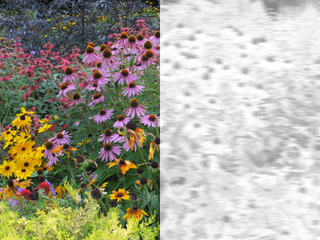By Melody Ocasio
Despite an enormous shift in society amid the coronavirus, significant strides in the field of gene therapy continue to be made.
Until recently, numerous patients with blinding visual disorders have had no treatment options, but now modern medicine is paving the way towards change.
Germany-based Drs. Dominik Fischer, Stylianos Michalakis and Barbara Wilhelm recently reported success in the first controlled human trial of gene therapy for complete color blindness.
Achromatopsia, a type of color blindness, is characterized by two categories; complete achromatopsia, in which an individual can only see black, white and shades of grey, and incomplete achromatopsia which allows an individual to distinguish only certain colors. According to the study, researchers treated nine patients with a gene that is connected to variations of achromatopsia, CNGA3. Patients with complete achromatopsia have a mutation in the CNGA3 gene.
Though only 1 in 30,000 individuals inherits the gene mutation that causes achromatopsia, the symptoms associated with the mutation cause discomfort for afflicted individuals. In addition to the inability to see color, one can have sensitivity to bright light, sensitivity to distinguish hues of grayscale, reduction in sharpness of vision and shaking eyes, also known as nystagmus.
The microsurgery procedure done by Michalakis and his team involved injecting a small virus into the center of the eye where the CNGA3 gene is mutated. Safety was the primary endpoint with efficacy following.
“What sounded like science fiction 20 or 30 years ago has now become a reality,” Michalakis said. “But, it has become a reality only for 1 out of almost 300 different conditions.”
The procedure was deemed safe and disease symptoms such as visual acuity and contrast sensitivity improved. However, achromatopsia is just one of hundreds of vision loss disorders that need gene therapy solutions.

“There is a clear unmet need here,” he said. “Vision is such an important sense for us that really, any effort is justified.”
The field of gene therapy has gone beyond the focus of treating cancer to treating vision loss in just the past three years. This change is being noted by the U.S Food and Drug Administration and has caused them to grow their expertise in the realm of gene therapy trials. Just this year the FDA made revisions to policies in order to continue to support gene therapy products. Ocular gene therapy research has improved dramatically since the first trial was conducted 20 years ago by William W. Hauswirth, Professor of Ophthalmology at the University of Florida College of Medicine.
Hauswirth and colleagues showed that mutations in the RPE65 gene caused a type of Lebers Congenital Amaurosis named LCA2, which causes vision loss from birth.
However, after an early phase clinical trial, Hauswirth’s research came to a halt due to lack of funds. Independently, Spark Therapeutics had the means to continue research and use Hauswirth’s patent for the vector design. This led to a medical breakthrough: Luxturna. Luxturna is the first and only approved FDA product to treat a blinding ocular disease, yet it only restores vision to patients with LCA2/RPE65, meaning only about 1-2,000 patients in the U.S.
Getting to this point of success is the challenge.
Each vision mutation has a window of opportunity. Some patients benefit from interventions earlier while others can be treated successfully later in life. Finding a patient base that fits a rare visual disorder is yet another factor that translates into why it takes the time it does for results to reach human trials and for products to reach the market.
“…the goal of gene therapy for inherited retinal disease is not only to improve vision but also do so as permanently as possible and preferably with a single treatment,” read the long term structural outcome of RPE65 study Hauswirth conducted.
Finding both short- and long-term measures when designing a study is the short-term objective. Seeing how effective a product will be, finding the safest way to deliver this product while also doing so through the least amount of treatments is the ultimate goal.
“There have not been any treatments for blinding diseases before gene therapy,” Hauswirth said. “It’s a whole new world.”
Melody Ocasio is a fourth-year student at the University of Florida. She is a Journalism major on the pre- optometry track hoping to communicate health science as a future O.D. Her expectations are to first attend a science writing graduate program and then enter optometry school in 2022. Growing up within the field of healthcare, as well as learning to love the field of journalism in middle school, Melody found a way to connect her two interests into a profession. The NASW mentorship was an opportunity for her to both learn and make connections with other students and mentors interested in the science journalism field.
This story was produced as part of NASW's David Perlman Summer Mentoring Program, which was launched in 2020 by our Education Committee. Ocasio was mentored by Pam Ronald.


